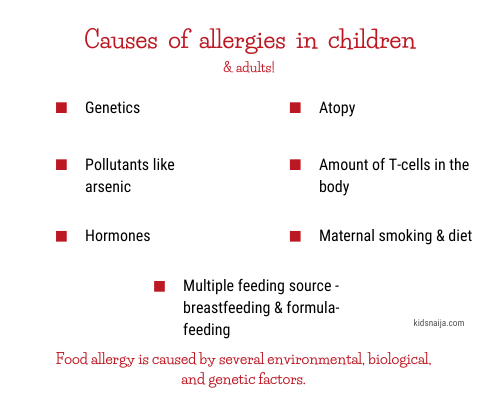There are tons of reasons why your baby might throw up on you after lunch, and food allergies in babies are just another reason.
But how on earth are you supposed to know that it’s an allergy (which is a big deal) and not just a little tummy irritation?
Simple, you watch, observe, and see a doctor confirm if an immune response is being triggered.
Food allergies in babies, children, and adults all trigger an immune response. That simply means that your body’s soldiers (the white blood cells) get all prepped up to fight against the “harmful intruder.”
But sadly, it’s just food, a non-harmful substance but they don’t know that hence food allergy symptoms are birthed.
- Is Food Allergy A Thing?
- 10 Most Common Food Allergies In Children
- Types Of Food Allergy
- 1. Immunoglobulin E (IgE) mediated food allergy
- 2. Non-Immunoglobulin E mediated food allergy
- 3. Mixed IgE and Non-IgE food allergy
- Symptoms Of Food Allergies
- What Causes Food Allergies In Children?
- Introducing Allergenic Foods To Babies
- How To Prevent Food Allergy In Children
- How To Treat Food Allergies In Babies
Is Food Allergy A Thing?
In some children and adult, the immune system wrongly identifies some foods as dangerous to the body. Their bodies react negatively to it by causing rashes on the skin, diarrhoea, vomiting, etc.
Hence, it’s now your job as a parent to monitor your child and identify these foods that cause allergic reactions and take them out of their meals.
But in Africa, it is quite common for parents to beat down the significance of monitoring your child’s foods for allergies. But this doesn’t change the fact that children can be allergic to foods, including foods they consume daily.
In a recent study, it was shown that more Asians and Africans had food allergies than before. With this growing statistics, it just wouldn’t make any sense thinking food allergies in children is meant for the Europeans and Americans.
From this study, it can be said that contrary to our belief, food allergy is an actual problem in Africa. Thus, parents ought to consciously monitor their children’s food to combat allergic reactions.
What Is A Food Allergy?
Food allergy is a condition by which the immune system wrongly identifies certain foods as harmful to the body. Therefore, it initiates different immune system responses to fight against this “harmful food”, this results in the signs and symptoms like vomiting, itchy mouth or skin, shortness of breath etc.
Food allergy can sometimes be confused with food intolerance because both conditions have similar signs and symptoms. But they are different, food allergy causes an immune system response while food intolerance does not.
Food intolerance triggers the digestive system. The body cannot digest certain foods because of the absence of an important enzyme in the body of that individual.
For instance, lactose intolerance is the most common type of food intolerance. It occurs due to the absence of the enzyme, lactase, that digests lactose that’s present in dairy products.
10 Most Common Food Allergies In Children
The most common food allergies in children include:
- Eggs
- Milk
- Peanut
- Shellfish
- Wheat
- Soy
- Fish
- Cereal e.g. corn, rice etc.
- Fruits and vegetable
- Tree nuts e.g. walnut, cashew, and almond.
Most allergic reactions in kids are caused by eggs, milk, and peanut. Allergies to tree nuts, peanuts, fish and shellfish often last a lifetime.
Kids might develop allergies immediately after consuming these foods or hours after, depending on the type of food allergy.
Types Of Food Allergy
1. Immunoglobulin E (IgE) mediated food allergy
IgE is an antibody (immune system soldier) that is responsible for fighting off infections and causing allergic reactions by initiating the release of certain chemicals to fight the intruders.
IgE-mediated food allergy is caused by immunoglobulin antibodies and their reactions are always immediate.
Symptoms include swollen mouth and tongue, teary eyes, itchy skin, nose congestion, anaphylaxis, etc.
2. Non-Immunoglobulin E mediated food allergy
In this case, other parts of the immune system like the T cells respond to the perceived threats (your food). Symptoms often take hours before they appear, this makes this type of allergic reaction more difficult to track down.
The symptoms of non-IgE mediated food allergies are mostly gastrointestinal/digestive system related. They include diarrhoea, bloating, vomiting, colic, etc.
3. Mixed IgE and Non-IgE food allergy
This is a type of food allergy that involves a combination of both type of food allergies discussed above.
Symptoms Of Food Allergies
- Paleness and rashes on the skin
- Cough
- Stomach upset
- Diarrhoea
- Anaphylactic shock – a life-threatening or severe allergic reaction.
- Nausea
- Dizziness
Are Babies Born With Food Allergies?
Babies can develop the risk of developing food allergies before birth.
Research shows that maternal diet during pregnancy, the way the baby is born, the season the baby was born; exposure to pollutants like tobacco smoke, as well as other factors, can affect the child’s chances of developing a food allergy.
What Causes Food Allergies In Children?
Food allergy is caused by several environmental, biological, and genetic factors. Some which include:

Atopy
Research proves that atopy is a leading cause of food allergy in children.
Atopy is a genetic condition that increases the tendency of you having an allergic reaction. And if you do have an allergic reaction, the symptoms are usually more severe than those of others It is characterised by fever, asthma, and various skin reactions. People with this genetic tendency are called atopic.
Atopic infants are at higher risk of developing food allergy than non-atopic infants.
Multiple feeding
In a study carried out in 2019 on 328 children, babies who were both breastfed and formula-fed at the same time were found to possess a higher risk of food allergy than children with only one feeding source, at a time.
Pollutants
Children exposed to arsenic, a water pollutant, are likely to experience allergic reactions like allergic rhinitis and asthma.
T-cell Concentration
The T-cell is an important component of the white blood cells. It is responsible for determining the exact response of the immune system to foreign bodies.
A type of T-cell called TH2A is found only in allergic persons and they are thought to cause allergic reactions.
The higher the concentration of TH2A in a child’s body, the higher the immune response, hence, the allergic reaction.
Hormones
The concentrations of certain hormones in the body increase your kid’s chance of developing a food allergy.
The hormone, oestrogen increases the risk of developing food allergies while testosterone offers protection against the attack.
This explains why boys with asthma, gradually outgrow it when they clock 10 owing to the increase in the male sex hormone – testosterone.
While the risks of girls developing asthma increases when puberty sets in – they now have increasing levels of oestrogen.
Maternal Smoking
Maternal smoking is associated with so many birth effects; it sometimes leads to preterm birth which might affect cognitive function.
Experts believe that maternal smoking may also be associated with allergic reactions like asthma, allergy rhinitis, and eczema in babies.
This is because tobacco increases the body’s ability to produce the antibody that mediates allergic reactions.
Babies whose mothers are active smokers – smoke at least one cigarette a day – or are exposed to tobacco smoke, are at higher risk of developing food allergies.
Genetics
If you or your partner is allergic to certain foods, then there is a chance that your baby might also be allergic to those foods. Sometimes, it’s in the genes!
Maternal Diet
Children of mothers who had a poor diet during pregnancy are at higher risk of developing food allergy compared to babies of mothers who had healthy diets.
Introducing Allergenic Foods To Babies
Allergenic sensitization is kind of like vaccination but different, it’s the art of trying to get the baby’s immune system to adapt to the allergen or become familiar with it – usually occurs within a child’s first year.
The way the immune system responds to the allergen and the amount of exposure to the allergen determine the level of the reaction.
Therefore, introducing allergens (allergic foods) to your baby might help the immune system adapt to the allergen. The goal is to help the immune system see the food as a friend, and not an enemy.
How To Prevent Food Allergy In Children
It might not be entirely possible to prevent food allergies in babies, but taking certain precautions might help.
- Expose your baby to allergens at an early age, this might reduce the child’s sensitivity to the allergen.
- Breastfeed your baby for the first 4 to 6 months. Breast milk hardly triggers allergic reactions.
- Be careful when you dine out with your kids because certain allergen might be in the food or on the cutleries.
- Feeding your baby solid foods like cereal or fruits one at a time would enable you to identify foods that your baby may be allergic to.
- Introduce vitamin D in your diet when pregnant. Vitamin D reduces food allergy in babies.
How To Treat Food Allergies In Babies
The best way to treat food allergy is avoidance.
Ensure that your child stays away from foods that trigger allergic reactions in them.
Also, you can train your child’s immune system by introducing a variety of antigen into the child during early childhood, mostly through vaccination.
Epinephrine injection is also used to treat food allergic reactions. It reverses life-threatening symptoms like anaphylaxis.
It’s a self-administered injection so, your child, if he/she is old enough, could carry it around. But consult your doctor to train you on how to use it properly.
Final Note
Food allergies in babies are gradually becoming a big issue in medical science. To curb the rising rate in Africa and all over the world, parents and caregivers must pay attention to their children’s diet.
As a parent, the best way to help your child beats food allergies is by monitoring the child’s reactions to certain food from infanthood.
This would enable you to identify and exclude the allergen from your child’s diet before it causes a hazard.


